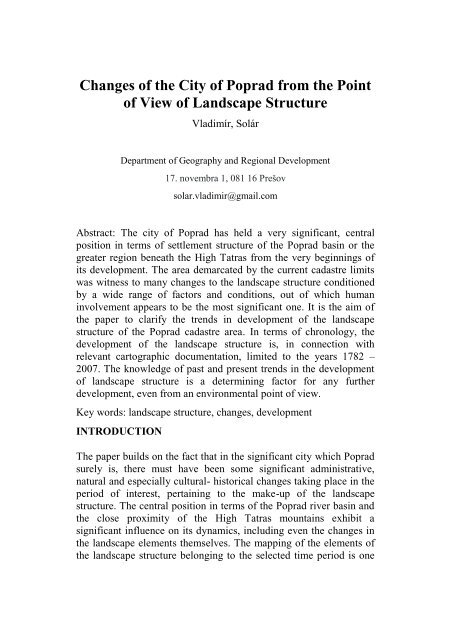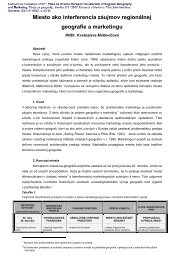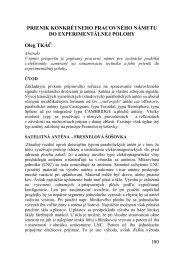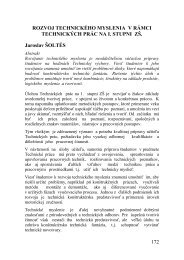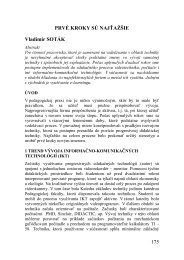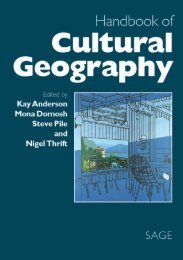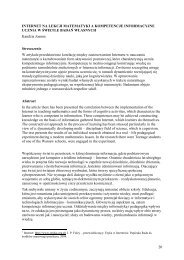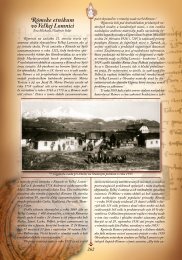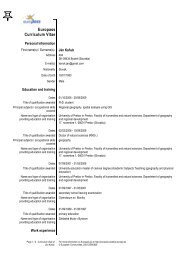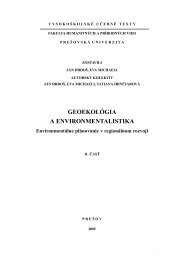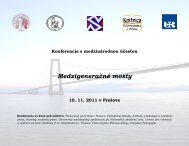Changes of the City of Poprad from the Point of View of Landscape ...
Changes of the City of Poprad from the Point of View of Landscape ...
Changes of the City of Poprad from the Point of View of Landscape ...
You also want an ePaper? Increase the reach of your titles
YUMPU automatically turns print PDFs into web optimized ePapers that Google loves.
<strong>Changes</strong> <strong>of</strong> <strong>the</strong> <strong>City</strong> <strong>of</strong> <strong>Poprad</strong> <strong>from</strong> <strong>the</strong> <strong>Point</strong><br />
<strong>of</strong> <strong>View</strong> <strong>of</strong> <strong>Landscape</strong> Structure<br />
Vladimír, Solár<br />
Department <strong>of</strong> Geography and Regional Development<br />
17. novembra 1, 081 16 Prešov<br />
solar.vladimir@gmail.com<br />
Abstract: The city <strong>of</strong> <strong>Poprad</strong> has held a very significant, central<br />
position in terms <strong>of</strong> settlement structure <strong>of</strong> <strong>the</strong> <strong>Poprad</strong> basin or <strong>the</strong><br />
greater region beneath <strong>the</strong> High Tatras <strong>from</strong> <strong>the</strong> very beginnings <strong>of</strong><br />
its development. The area demarcated by <strong>the</strong> current cadastre limits<br />
was witness to many changes to <strong>the</strong> landscape structure conditioned<br />
by a wide range <strong>of</strong> factors and conditions, out <strong>of</strong> which human<br />
involvement appears to be <strong>the</strong> most significant one. It is <strong>the</strong> aim <strong>of</strong><br />
<strong>the</strong> paper to clarify <strong>the</strong> trends in development <strong>of</strong> <strong>the</strong> landscape<br />
structure <strong>of</strong> <strong>the</strong> <strong>Poprad</strong> cadastre area. In terms <strong>of</strong> chronology, <strong>the</strong><br />
development <strong>of</strong> <strong>the</strong> landscape structure is, in connection with<br />
relevant cartographic documentation, limited to <strong>the</strong> years 1782 –<br />
2007. The knowledge <strong>of</strong> past and present trends in <strong>the</strong> development<br />
<strong>of</strong> landscape structure is a determining factor for any fur<strong>the</strong>r<br />
development, even <strong>from</strong> an environmental point <strong>of</strong> view.<br />
Key words: landscape structure, changes, development<br />
INTRODUCTION<br />
The paper builds on <strong>the</strong> fact that in <strong>the</strong> significant city which <strong>Poprad</strong><br />
surely is, <strong>the</strong>re must have been some significant administrative,<br />
natural and especially cultural- historical changes taking place in <strong>the</strong><br />
period <strong>of</strong> interest, pertaining to <strong>the</strong> make-up <strong>of</strong> <strong>the</strong> landscape<br />
structure. The central position in terms <strong>of</strong> <strong>the</strong> <strong>Poprad</strong> river basin and<br />
<strong>the</strong> close proximity <strong>of</strong> <strong>the</strong> High Tatras mountains exhibit a<br />
significant influence on its dynamics, including even <strong>the</strong> changes in<br />
<strong>the</strong> landscape elements <strong>the</strong>mselves. The mapping <strong>of</strong> <strong>the</strong> elements <strong>of</strong><br />
<strong>the</strong> landscape structure belonging to <strong>the</strong> selected time period is one
<strong>of</strong> <strong>the</strong> elementary methods <strong>of</strong> research <strong>of</strong> landscape structure in<br />
terms <strong>of</strong> <strong>the</strong> LANDEP methodology (Ružička, Miklós, 1982). The<br />
environment <strong>of</strong> a geographic information systems (GIS), more<br />
specifically <strong>the</strong> proprietary s<strong>of</strong>tware Arc <strong>View</strong>, creates a suitable<br />
environment for <strong>the</strong> processing and evaluation <strong>of</strong> landscape<br />
structure, as presented in works by Boltižiar (2007), Ivanová (2006),<br />
Olah, Boltižiar, Petrovič (2006), and o<strong>the</strong>rs.<br />
METHODOLOGY<br />
The area <strong>of</strong> research is demarcated by <strong>the</strong> current cardastre limits <strong>of</strong><br />
<strong>the</strong> city <strong>of</strong> <strong>Poprad</strong>. It was created by a continuous merging <strong>of</strong> <strong>the</strong><br />
autonomous administrative units <strong>of</strong> <strong>Poprad</strong>, Matejovce, Spišská<br />
Sobota, Stráže and Veľká. The demarcated region spreads over an<br />
area <strong>of</strong> 6 293 ha. The analysis <strong>of</strong> <strong>the</strong> area <strong>of</strong> <strong>the</strong> city <strong>of</strong> <strong>Poprad</strong> makes<br />
use <strong>of</strong> <strong>the</strong> analysis <strong>of</strong> elements <strong>of</strong> secondary landscape structure in<br />
terms <strong>of</strong> <strong>the</strong> LANDEP methodology (Ružička, 2000). In order to<br />
capture <strong>the</strong> dynamics <strong>of</strong> <strong>the</strong> landscape structure, <strong>the</strong> individual<br />
elements are divided into eight groups: 1 Group <strong>of</strong> elements <strong>of</strong> forest<br />
and non-forest vegetation, 2 Group <strong>of</strong> elements <strong>of</strong> permanent<br />
grassland, 3 Group <strong>of</strong> elements <strong>of</strong> agricultural crops, 4 Group <strong>of</strong><br />
elements <strong>of</strong> subsoil and substrate, 5 Group <strong>of</strong> elements <strong>of</strong> rivers and<br />
water areas, 6 Group <strong>of</strong> settlements and recreation areas, 7 Group <strong>of</strong><br />
technical elements, 8 Group <strong>of</strong> transportation elements. The elements<br />
were identified with <strong>the</strong> use <strong>of</strong> analogue interpretation <strong>of</strong><br />
cartographic documentation <strong>from</strong> six temporal horizons, chosen<br />
depending on <strong>the</strong>ir availability (1782, 1882, 1877, 1956, 1986,<br />
2007). Digital vector processing <strong>of</strong> <strong>the</strong> maps was performed using<br />
<strong>the</strong> Arc <strong>View</strong> 10 s<strong>of</strong>tware base, where each polygon was assigned a<br />
numeric and verbal attribute. Subsequently, area quotients <strong>of</strong><br />
landscape element groups in <strong>the</strong> respective temporal horizons were<br />
evaluated and compared.<br />
RESULTS<br />
The area <strong>of</strong> <strong>the</strong> city <strong>of</strong> <strong>Poprad</strong> in <strong>the</strong> 1782 temporal horizon exhibited<br />
24 landscape elements in six elementary groups, with a <strong>the</strong> largest<br />
area quotient <strong>of</strong> 4584,87 ha in <strong>the</strong> third group <strong>of</strong> elements <strong>of</strong><br />
agricultural cultures. The lowest area was made up <strong>of</strong> <strong>the</strong> elements <strong>of</strong><br />
<strong>the</strong> fifth group – water courses and surfaces. In <strong>the</strong> latest and most
current temporal horizon <strong>of</strong> 2007, 61 landscape elements in eight<br />
groups were identified. The largest area <strong>of</strong> 3501, 73 ha was taken up<br />
by <strong>the</strong> third group <strong>of</strong> elements <strong>of</strong> agricultural cultures and, on <strong>the</strong><br />
o<strong>the</strong>r hand, <strong>the</strong> lowest area was take up by <strong>the</strong> elements <strong>of</strong> <strong>the</strong> fourth<br />
group – subsoil and substrate. A complex view <strong>of</strong> <strong>the</strong> area division<br />
<strong>of</strong> groups <strong>of</strong> landscape elements in terms <strong>of</strong> <strong>the</strong> researched temporal<br />
horizons is presented in Table 1. Map 1 demonstrates <strong>the</strong> spatial<br />
placement and proportional representation <strong>of</strong> <strong>the</strong> individual groups<br />
<strong>of</strong> landscape elements in a chronological order.<br />
Tab.1: Spatial rates <strong>of</strong> <strong>the</strong> groups <strong>of</strong> landscape elements<br />
Group <strong>of</strong><br />
landscape<br />
elements<br />
Area<br />
in ha<br />
1782<br />
Area<br />
in ha<br />
1822<br />
Area<br />
in ha<br />
1877<br />
Area<br />
in ha<br />
1956<br />
Area<br />
in ha<br />
1986<br />
Area<br />
in ha<br />
2007<br />
1 703,74 662,11 766,68 768,88 744,17 777,32<br />
2 795,79 1104,90<br />
3<br />
4594,8<br />
4<br />
4312,92<br />
1002,8<br />
2<br />
4279,4<br />
5<br />
1462,4<br />
2<br />
3481,1<br />
6<br />
1279,10 674,28<br />
3225,09 3501,73<br />
4 0 0 0 1,25 1,25 3,40<br />
5 24,02 24,88 24,88 24,49 24,41 24,43<br />
6 112,58 118,13 130,46 291,24 605,35 732,70<br />
7 0 0 0,33 147,67 208,66 240,24<br />
8 62,04 70,07 88,38 115,89 204,97 338,90<br />
Toge<strong>the</strong>r 6293 6293 6293 6293 6293 6293<br />
Source: Vladimír Solár (2011)<br />
In terms <strong>of</strong> <strong>the</strong> researched timespan <strong>of</strong> 225 years, <strong>the</strong> landscape<br />
structure <strong>of</strong> <strong>the</strong> area has changed significantly, or let us say that <strong>the</strong><br />
proportional representation <strong>of</strong> <strong>the</strong> landscape elements has changed.<br />
The largest decrease <strong>of</strong> 1093,11 ha was present in <strong>the</strong> third group <strong>of</strong><br />
elements <strong>of</strong> agricultural cultures (Graph 1).
Significant increase <strong>of</strong> 620,12 ha <strong>of</strong> land was recorder within <strong>the</strong><br />
sixth group <strong>of</strong> settlement elements and recreational facilities, within<br />
<strong>the</strong> eight group or elements <strong>of</strong> transportation (276,86 ha) and <strong>the</strong><br />
group <strong>of</strong> technological elements (240,24 ha). Apart <strong>from</strong> <strong>the</strong><br />
elements <strong>of</strong> <strong>the</strong> water courses and surfaces group, <strong>the</strong> most stable<br />
areas include elements <strong>of</strong> coniferous forests situated in <strong>the</strong> western<br />
part <strong>of</strong> <strong>the</strong> area and elements <strong>of</strong> large-scale fields in <strong>the</strong> south-west.<br />
The proportion <strong>of</strong> natural elements (groups 1 – 5) to o<strong>the</strong>r elements<br />
created by man (groups 6 – 8) was, in <strong>the</strong> year 1782, calculated as<br />
35:1 or 97,23% to 2,77% in respect to <strong>the</strong> total and in <strong>the</strong> year 2007<br />
as 3,8:1 or 79,15% to 20,85%, which indicates an almost eight-fold<br />
increase.<br />
Graph 1: <strong>Changes</strong> in <strong>the</strong> groups <strong>of</strong> landscape elements <strong>from</strong><br />
1782-2007<br />
Source: Vladimír Solár (2011)<br />
CONCLUSION<br />
According to Lipský (2002), <strong>the</strong> observation and detailed evaluation<br />
<strong>of</strong> <strong>the</strong> historical development <strong>of</strong> an area is one <strong>of</strong> <strong>the</strong> elementary<br />
steps in solving current landscape-ecological problems. In terms <strong>of</strong><br />
<strong>the</strong> aim, trends in <strong>the</strong> development <strong>of</strong> <strong>the</strong> landscape structure <strong>of</strong> <strong>the</strong><br />
cadastre area <strong>of</strong> <strong>the</strong> city <strong>of</strong> <strong>Poprad</strong> were analysed and clarified. In <strong>the</strong><br />
last 225 years, <strong>the</strong> cadastre area <strong>of</strong> <strong>the</strong> city <strong>of</strong> <strong>Poprad</strong> went through<br />
apparent changes in <strong>the</strong> landscape structure. It was especially <strong>the</strong>
connection <strong>of</strong> <strong>the</strong> city to <strong>the</strong> main traffic lines towards <strong>the</strong> end <strong>of</strong> <strong>the</strong><br />
19 th century that fuelled <strong>the</strong> development <strong>of</strong> industry and <strong>the</strong><br />
subsequent construction <strong>of</strong> settlements, which caused <strong>the</strong> rapid<br />
decrease in agricultural land and a slight decrease in <strong>the</strong> area <strong>of</strong> grass<br />
overgrowths. The o<strong>the</strong>r groups <strong>of</strong> elements exhibited an increase in<br />
<strong>the</strong>ir area proportion, at <strong>the</strong> expense <strong>of</strong> <strong>the</strong> two previously mentioned<br />
groups. Man, by means <strong>of</strong> his activities in <strong>the</strong> course <strong>of</strong> <strong>the</strong> last 225<br />
years, has significantly influenced <strong>the</strong> development <strong>of</strong> <strong>the</strong> landscape<br />
structure in <strong>the</strong> area <strong>of</strong> <strong>the</strong> city <strong>of</strong> <strong>Poprad</strong>, which is reflected by <strong>the</strong><br />
proportional representation <strong>of</strong> <strong>the</strong> individual groups <strong>of</strong> landscape<br />
elements.<br />
References<br />
[1] BOLTIŽIAR, M. 2007 Štruktúra vysokohorskej krajiny Tatier.<br />
FPV UKF v Nitre, edícia Prírodovedec č. 280, 248 p.<br />
[2] IVANOVÁ, M. 2006 Zmeny v krajinnej štruktúre<br />
podvihorlatských obcí Vinné, Kaluža, Klokočov, Kusín a Jovsa.<br />
In: Geografická revue Katedra geografie Fakulty Prírodných<br />
vied Univerzity Mateja Bela v Banskej Bystrici, Roč. 2, č. 2, p.<br />
130-134, ISSN 1336-7072.<br />
[3] LIPSKÝ, Z. 2002 Sledování historického vývoje krajinné<br />
struktury s využitím starých map. In: Němec, J., (ed.) Krajina<br />
2002 od poznání k integraci. Ministerstvo životního prostředí,<br />
Ústí nad Labem, p. 44-48.<br />
[4] OLAH, B., BOLTIŽIAR, M., PETROVIČ, F. 2006. Land use<br />
changes’ relation to georelief and distance in <strong>the</strong> East<br />
Carpathians Biosphere Reserve. In: Ekológia (Bratislava) Vol.<br />
25, Nr. 1, p. 68-81.<br />
[5] RUŽIČKA, M. 2000 Krajinnoekologické plánovanie –<br />
LANDEP I. Vydavateľstvo Biosféra, Bratislava, 120 p.<br />
[6] RUŽIČKA, M., MIKLÓS, L. 1982 <strong>Landscape</strong> ecological<br />
planning (LANDEP) in <strong>the</strong> process <strong>of</strong> territorial planning. In:<br />
Ekológia – ČSSR Nr. 1, Vol. 3. Bratislava: ÚKE SAV, 1982,<br />
p.297-312
Shrnutí<br />
Město <strong>Poprad</strong> tvoří centrum <strong>Poprad</strong>ské kotliny. V krajinné struktuře<br />
na území města <strong>Poprad</strong> probíhaly ve sledovaném období r. 1782-<br />
2007 neustálé změny. Nejmarkantnější jsou tyto změny patrné na<br />
úbytku plochy ve skupině zemědělských kultur. Dlouhodobý růst<br />
dosahovaly během celého období skupiny sídelních prvků a<br />
rekreačních prostorov, technických prvků i prvků dopravy. Celkový<br />
podíl přírodní složky v rámci krajinné struktury poklesl během<br />
sledovaného období o 18,08%. Stabilní část území v celém období<br />
tvořil jižní okraj katastrálního území města <strong>Poprad</strong> s prvky<br />
jehličnatých lesů. Za celé období stoupl počet krajinných prvků z 24<br />
v r. 1782 na 61 v r. 2007. Poznání trendů vývoje krajinné struktury je<br />
důležité z hlediska predikce a trvalé udržitelnosti předmětného<br />
území.<br />
Príspevok je súčasťou grantového projektu VEGA č. 1/0451/10<br />
Geoekologické dimenzie vybraných environmentálnych záťaží v Slovenskej<br />
republike. Vedúci projektu: Pr<strong>of</strong>. RNDr. Eva Michaeli, PhD


